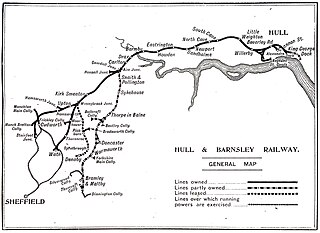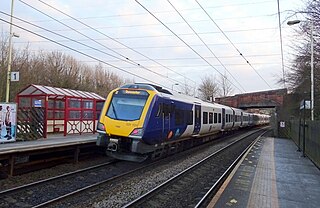
The Great Central Railway in England was formed when the Manchester, Sheffield and Lincolnshire Railway changed its name in 1897, anticipating the opening in 1899 of its London Extension. On 1 January 1923, the company was grouped into the London and North Eastern Railway.

The Dearne Valley is an area of South Yorkshire, England, along the River Dearne. It encompasses the towns of Wombwell, Wath-upon-Dearne, Swinton, Conisbrough and Mexborough, the large villages of Ardsley, Bolton on Dearne, Goldthorpe, Thurnscoe, Darfield, Stairfoot and Brampton Bierlow, and many other smaller villages and hamlets.

The Hull Barnsley & West Riding Junction Railway and Dock Company (HB&WRJR&DCo.) was opened on 20 July 1885. It had a total projected length of 66 miles but never reached Barnsley, stopping a few miles short at Stairfoot. The name was changed to The Hull and Barnsley Railway (H&BR) in 1905. Its Alexandra Dock in Hull opened 16 July 1885.

The Wakefield line is a railway line and service in the West Yorkshire Metro and South Yorkshire Passenger Transport Executive areas of northern England. The Wakefield line is coloured yellow on maps and publications by West Yorkshire Metro. The line was electrified in 1989, between Leeds & Wakefield Westgate, as part of the programme to electrify the East Coast Main Line.

Wath upon Dearne is a town south of the River Dearne in the Metropolitan Borough of Rotherham, South Yorkshire, England, 5 miles (8 km) north of Rotherham and almost midway between Barnsley and Doncaster. It had a population of 11,816 at the 2011 census. It is twinned with Saint-Jean-de-Bournay in France.

Wath railway station was one of three railway stations in Wath-upon-Dearne, South Yorkshire, England. It was the southern terminus of The Hull & South Yorkshire Extension Railway which became part of the Hull and Barnsley Railway in 1898 and was the southern terminus of a branch line from Wrangbrook Junction. The station was located on Station Road between the Great Central Railway's Wath Central station and the Midland Railway's Wath North station. Branch line trains connected with Sheffield-Cudworth-Hull trains at Wrangbrook.
The South Yorkshire Railway was a railway company with lines in the West Riding of Yorkshire, England.

Denaby and Conisbrough railway station was a small station, the southern terminus of the South Yorkshire Junction Railway branch from Wrangbrook Junction. The station, built to serve Denaby Main and Conisbrough, near Doncaster, South Yorkshire, England, was situated just to the north of the Mexborough to Doncaster line of the Manchester, Sheffield and Lincolnshire Railway, close by the road linking the villages in its name. Access to the station was by a subway under the G.C. line.

The South Yorkshire Junction Railway was a railway which ran from Wrangbrook Junction on the main line of the Hull and Barnsley Railway to near Denaby Main Colliery Village, South Yorkshire. It was nominally an independent company sponsored by the Denaby and Cadeby Colliery Company but was worked by the Hull and Barnsley Railway.
The Dearne Valley Railway (DVR) was a railway line which ran through the valley of the River Dearne in South Yorkshire, England. It was incorporated by an Act of Parliament on 6 August 1897, which authorised the building of a line between Brierley Junction, on the main line of the Hull and Barnsley Railway, to junctions with the Great Northern Railway and the Great Northern and Great Eastern Joint Railway south-east of Doncaster.

Hickleton and Thurnscoe Halt was a small railway station on the Hull and Barnsley Railway line between Wrangbrook Junction and Wath-upon-Dearne. The halt was built to serve the mining villages of Hickleton and Thurnscoe, near Barnsley, South Yorkshire and was situated in the centre of Thurnscoe at the point where the line crosses over the main Barnsley road. Hickleton village was situated over 0.5 miles (0.8 km) away.

Moorhouse and South Elmsall Halt was a railway station situated on the Hull and Barnsley Railway's branch line from Wrangbrook to Wath-upon-Dearne. The station served the village of Moorhouse and the town of South Elmsall on the South Yorkshire / West Yorkshire boundary, although this was about a mile distance. The station is located between Hickleton and Thurnscoe and Wrangbrook Junction, where the Wath branch joined the main line. The single storey station building, on the Wath-bound platform was, unlike the others on the line, built of brick with a slate roof. The other platform had just a simple waiting room for the few passengers who used the station. The platform surfaces were gravel and stone edged. The station master's house, of a standard Hull and Barnsley style, was situated a road level by the underbridge.

The West Riding and Grimsby Railway was a railway company that promoted a line between Wakefield and Doncaster, in Yorkshire, England. There was also a branch line connection from Adwick le Street to Stainforth, which gave access towards Grimsby. The company was promoted independently, but it was sponsored by the Manchester, Sheffield and Lincolnshire Railway and the Great Northern Railway, and became jointly owned by them.
Kilnhurst Colliery, formerly known as either Thrybergh or Thrybergh Hall Colliery, was situated on the southern side of the village of Kilnhurst, near Rotherham, South Yorkshire, England.

Barnburgh Main Colliery was a coal mine situated on the outskirts of the village of Barnburgh, about two miles north of Mexborough in the Dearne Valley, South Yorkshire, England. The sinking of the colliery was commenced in 1911 by the Manvers Main Colliery Company of Wath-upon-Dearne.
The Lancashire, Derbyshire and East Coast Railway (LD&ECR) was built to connect coalfields in Derbyshire and Nottinghamshire with Warrington and a new port on the Lincolnshire coast. It was a huge undertaking, and the company was unable to raise the money to build its line. With the financial help of the Great Eastern Railway it managed to open between Chesterfield and Lincoln with a branch towards Sheffield from 1896. Despite efforts to promote tourist travel, the passenger business was never buoyant, but collieries were connected to the line, at first and in succeeding years. The Great Eastern Railway, and other main line companies, transported coal to the southern counties, and the company's engines took coal to Immingham in great quantities. The company had a fleet of tank engines.

Wrangbrook Junction near Upton in West Yorkshire was a location where two lines branched off the Hull and Barnsley Railway main line from Hull Cannon Street to Cudworth. The first junction led to Denaby and Conisbrough on the South Yorkshire Junction Railway, and after some four chains further the Hull & South Yorkshire Extension Railway to Wath diverged. The line between Hull and Cudworth had opened on 20 July 1885, the branch to Denaby on 1 September 1894 and the one to Wath on 31 March 1902.

Kirk Smeaton railway station is located on the east side of Willowbridge Road in Little Smeaton, North Yorkshire, England. It opened on 22 July 1885, two days after the Hull Barnsley and West Riding Junction Railway and Dock Company opened the line between Hull Cannon Street and Cudworth. The station had two facing platforms, the brick-built main station building in "domestic revival style" was on the down side, while the up platform had a waiting room. At the east end of the down platform was a signal box which controlled the goods yard. The latter consisted of four sidings, but had no goods shed.
The East and West Yorkshire Union Railway was promoted in 1883 to connect the Hull and Barnsley Railway at Drax with Leeds. The company was unable to raise the money it needed to build the line, and it substantially reduced its scope to connecting collieries around Rothwell with the existing main line network nearby. This was successful, with trains running from 1890, but the company decided it would find a way to connect to Leeds and operate a much truncated passenger service, from Rothwell. It sponsored the South Leeds Junction Railway to make a connection from Rothwell to the Midland Railway at Stourton; the SLJR was soon re-absorbed by the E&WYUR. The passenger service started on 4 January 1904 but it was a disastrous failure, and it was soon withdrawn from 1 October 1904.
The Leen Valley lines of the Great Northern Railway were railway branch lines built to access the collieries in the Nottinghamshire coalfield in England. The Midland Railway had long been dominant in the area, but there was resentment against its monopolistic policies from coalowners, who encouraged the Great Northern Railway to build a line. The Leen Valley Line was opened in 1881; it ran as far as Annesley colliery. A passenger service was run the following year, and very considerable volumes of coal were hauled.













